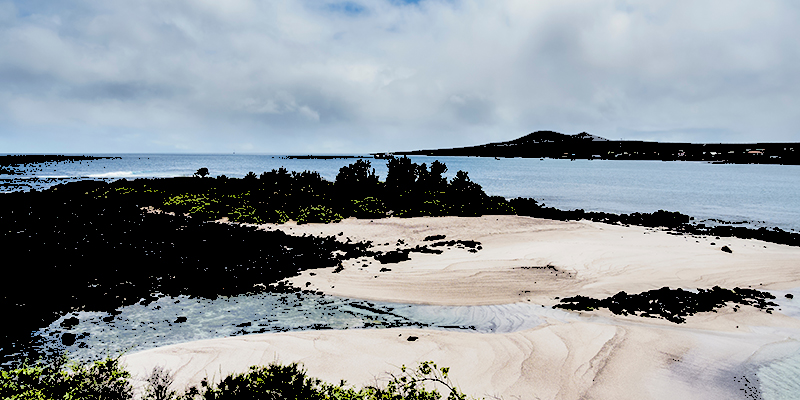“A woman who doesn’t lie,” wrote Agatha Christie, “is a woman without imagination and without sympathy.” I’ve thought often of this passage while writing my new nonfiction book, Eden Undone. Told largely through the perspectives of two female protagonists, Eden Undone is the true story of a group of European exiles who tried to create a utopia on a remote Galápagos island. While I was fortunate to have a surfeit of primary sources—both women wrote detailed memoirs and letters about their experiences—the material also presented a unique challenge: How could I craft a true crime narrative based on conflicting, and sometimes deliberately deceitful, accounts?
We begin in 1929 with Dore Strauch, a 26-year-old German woman who had grown disillusioned with her life. Trapped in a tedious marriage and suffering from multiple sclerosis, she checked herself into a Berlin hospital. It was a decision with far-reaching consequences, thanks to presence of a certain Dr. Friedrich Ritter, who took a special interest in her case. Fifteen years her senior, profoundly eccentric, with many unconventional ideas about medicine and health, Friedrich insisted Dore could heal herself simply by using the power of her mind. He aspired to be a philosopher and introduced her to the works of Nietzsche and Laozi. He intended to live for at least 150 years, he said, and argued that a carnivorous diet would hasten the end of European culture. He did not trust manufactured clothing, especially the “civilized” shoe.
In fact, he trusted nothing civilization had to offer and had long been desperate to flee it. Dore, he announced, must move with him to Floreana, an uninhabited island in the southern part of the Galápagos archipelago.
Their meeting was fated, Dore thought. It was her purpose in life to support his writing and spread his ideas throughout the world, to help him attain the status of übermensch as described in Nietzsche’s work. With great excitement and purpose they built a home on Floreana and called it “Friedo,” a portmanteau of their names. But their relationship soon took a troubling turn. Friedrich could be dismissive, even cruel, and Dore began to rebel against his rules and demands. When wealthy American explorers heard of the “modern-day Adam and Eve” and traveled to meet Dore and Friedrich, they noticed that the couple’s bright and happy façade masked a complicated tension—a tension that Dore would underplay in her memoir, Satan Came to Eden, while omitting altogether serious incidents of Friedrich’s escalating abuse.
Memoir writing inevitably contains a bit of revisionist history; people don’t always recall conversations verbatim, and the passage of time can obfuscate memories, amplifying the bright and softening the dark, shifting how they sit in our minds. In the case of Dore, I also had to consider the mental and physical trauma she experienced during her time on Floreana; numerous objective witnesses reported Friedrich’s poor treatment of Dore. Her recollection of events in Satan Came to Eden could, in retrospect, be viewed not only as a burnishing of Friedrich’s legacy but also as an attempt at self-preservation, establishing a near-truth she could accept while burying hard truths she could not.
Navigating Dore’s recollections grew more challenging with the arrival on Floreana of a second group of European exiles. In early 1932, Margret Waldbröl left Berlin with her older fiancé, Heinz Wittmer, a high-ranking official in the Weimar Republic, and his young son from a previous marriage, Harry. They had heard of Dore and Friedrich’s experiment on Floreana and were eager to escape Germany, since Adolf Hitler and his Nazi Party were on the ascent. Margret, five months pregnant, hoped to live a quiet and simple life on the island, and anticipated a cordial relationship with their new neighbors.
Dore and Margret, however, instantly disliked each other. Margret scoffed at Dore’s philosophical posturing, and Dore considered Margret “an ordinary type of woman” and an “idiot” for choosing to give birth in such a remote locale. Later, in their respective memoirs, each woman wrote of her animosity for the other, but they diverged on several details. Dore wrote that she begrudgingly loaned Margret a donkey to help transport their belongings; Margret, in her memoir Floreana, insisted that her request for help was denied altogether. Margret also said that she did not intend to trouble Friedrich for medical care, while Dore said Margret was overt in her expectations. Such petty discrepancies could be dismissed as inconsequential in the context of neighborly relations. But as I would eventually learn, they were indicative of the narrative complexities to come. With the arrival of a third group of exiles, Dore’s and Margret’s accounts began to diverge in dramatically different ways—differences that, upon further research, laid bare their motivations for deceit.
Baroness Antonia Wagner von Wehrborn Bosquet sailed from Amsterdam to Floreana in July 1932, accompanied by two male lovers, Rudolph Lorenz and Robert Philippson. (She left her husband, a French war hero, back in Paris.) Upon arriving on Floreana, she announced her plans to build a Miami-style resort for American millionaires, washed her feet in the source of the Wittmers’ drinking water, and antagonized both Margret and Dore by trying to seduce their partners. The atmosphere on Floreana, already tense, grew terrifying; Dore wrote of “vague and ominous presentiments” that “crystallized into a feeling of murder.” Her fears were justified: two exiles ended up missing and two others dead, with the survivors—namely Dore and Margret—hurling accusations of murder.
Instead of choosing which woman’s version was most reliable and relating the story solely through her perspective, I decided that their deceptions had to be an integral part of the story. What people choose to lie about or omit can be just as illuminating as the truth; excluding their lies would have been its own sort of deception. Dore claimed that she and Friedrich heard a woman’s scream at noon on a certain day—a scream that would have been impossible to hear from their location at Friedo, and one that she never mentioned when questioned by Ecuadorian authorities. Was she providing an alibi for Friedrich, to whom she remained devoted? Margret, for her part, claimed that the Baroness and one of her companions set sail for Tahiti on a passing yacht—a yacht that no one else had seen and that did not appear on any list of visiting ships. Was she providing an alibi for Heinz, or for Rudolph Lorenz, who had fallen from the Baroness’s favor? Multiple times the women also accused each other of lying directly. Using numerous unbiased accounts from visitors to the island, I was able to deduce—much like a prosecutor presenting a closing argument to the jury—the most likely chain of events during those fateful, and fatal, months on Floreana.
Still, I wonder what I might be missing, and what mysteries will be forever lost to time. I’m haunted by something Margret often said to visitors, decades after the other exiles were gone: En boca cerrada, no entran moscas—“a closed mouth omits no flies.” She died in 2000, taking the secrets of Floreana to her grave. But it seems safe to assume that—much like the group who assemble on Soldier Island in Agatha Christie’s And Then There Were None—all of the Floreana exiles were guilty of something.
***


















